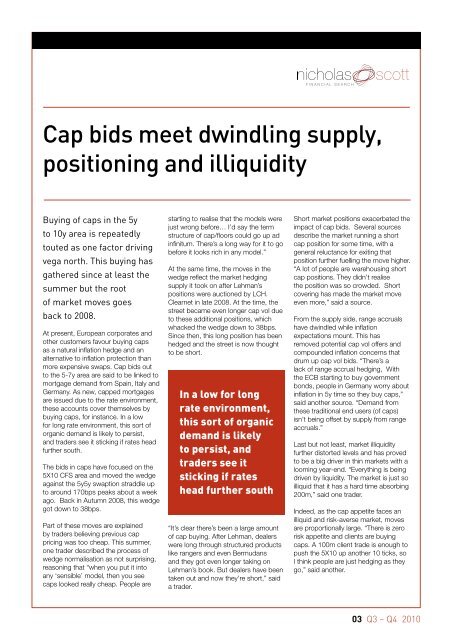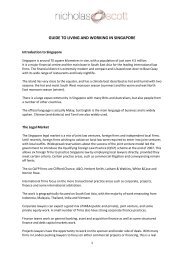Derivative News - Nicholas Scott
Derivative News - Nicholas Scott
Derivative News - Nicholas Scott
- No tags were found...
You also want an ePaper? Increase the reach of your titles
YUMPU automatically turns print PDFs into web optimized ePapers that Google loves.
Cap bids meet dwindling supply,<br />
positioning and illiquidity<br />
Buying of caps in the 5y<br />
to 10y area is repeatedly<br />
touted as one factor driving<br />
vega north. This buying has<br />
gathered since at least the<br />
summer but the root<br />
of market moves goes<br />
back to 2008.<br />
At present, European corporates and<br />
other customers favour buying caps<br />
as a natural inflation hedge and an<br />
alternative to inflation protection than<br />
more expensive swaps. Cap bids out<br />
to the 5-7y area are said to be linked to<br />
mortgage demand from Spain, Italy and<br />
Germany. As new, capped mortgages<br />
are issued due to the rate environment,<br />
these accounts cover themselves by<br />
buying caps, for instance. In a low<br />
for long rate environment, this sort of<br />
organic demand is likely to persist,<br />
and traders see it sticking if rates head<br />
further south.<br />
The bids in caps have focused on the<br />
5X10 CFS area and moved the wedge<br />
against the 5y5y swaption straddle up<br />
to around 170bps peaks about a week<br />
ago. Back in Autumn 2008, this wedge<br />
got down to 38bps.<br />
Part of these moves are explained<br />
by traders believing previous cap<br />
pricing was too cheap. This summer,<br />
one trader described the process of<br />
wedge normalisation as not surprising,<br />
reasoning that “when you put it into<br />
any ‘sensible’ model, then you see<br />
caps looked really cheap. People are<br />
starting to realise that the models were<br />
just wrong before… I’d say the term<br />
structure of cap/floors could go up ad<br />
infinitum. There’s a long way for it to go<br />
before it looks rich in any model.”<br />
At the same time, the moves in the<br />
wedge reflect the market hedging<br />
supply it took on after Lehman’s<br />
positions were auctioned by LCH.<br />
Clearnet in late 2008. At the time, the<br />
street became even longer cap vol due<br />
to these additional positions, which<br />
whacked the wedge down to 38bps.<br />
Since then, this long position has been<br />
hedged and the street is now thought<br />
to be short.<br />
“It’s clear there’s been a large amount<br />
of cap buying. After Lehman, dealers<br />
were long through structured products<br />
like rangers and even Bermudans<br />
and they got even longer taking on<br />
Lehman’s book. But dealers have been<br />
taken out and now they’re short,” said<br />
a trader.<br />
Short market positions exacerbated the<br />
impact of cap bids. Several sources<br />
describe the market running a short<br />
cap position for some time, with a<br />
general reluctance for exiting that<br />
position further fuelling the move higher.<br />
“A lot of people are warehousing short<br />
cap positions. They didn’t realise<br />
the position was so crowded. Short<br />
covering has made the market move<br />
even more,” said a source.<br />
From the supply side, range accruals<br />
have dwindled while inflation<br />
expectations mount. This has<br />
removed potential cap vol offers and<br />
compounded inflation concerns that<br />
drum up cap vol bids. “There’s a<br />
lack of range accrual hedging, With<br />
the ECB starting to buy government<br />
bonds, people in Germany worry about<br />
inflation in 5y time so they buy caps,”<br />
said another source. “Demand from<br />
these traditional end users (of caps)<br />
isn’t being offset by supply from range<br />
accruals.”<br />
Last but not least, market illiquidity<br />
further distorted levels and has proved<br />
to be a big driver in thin markets with a<br />
looming year-end. “Everything is being<br />
driven by liquidity. The market is just so<br />
illiquid that it has a hard time absorbing<br />
200m,” said one trader.<br />
Indeed, as the cap appetite faces an<br />
illiquid and risk-averse market, moves<br />
are proportionally large. “There is zero<br />
risk appetite and clients are buying<br />
caps. A 100m client trade is enough to<br />
push the 5X10 up another 10 ticks, so<br />
I think people are just hedging as they<br />
go,” said another.<br />
03 Q3 – Q4 2010







